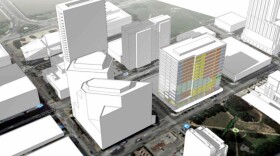From the Austin Monitor: Travis County’s renewed search for a suitable site for a new civil courthouse is facing stiff headwinds from a state law aimed at stifling development in downtown Austin.
Last Wednesday, the Civil and Family Courthouse Community Advisory Committee showed little interest in taking on the Texas Legislature and the Capitol View Corridors that the body established back in the early 1980s.
The guidelines regarding the view corridors forbid construction of any buildings that would block views of the Capitol dome from various, arbitrarily selected sites around Austin.
Travis County Strategic Resource Planning Manager Belinda Powell on Wednesday showed the committee how the restrictions disqualify from consideration two perfectly suited county-owned properties.
One property, known as Block 126, sits on Guadalupe Street across from the 85-year-old Heman Marion Sweatt Travis County Courthouse that the county is looking to replace. The other comprises half of Block 134 just to the northeast of the aging building and is the current site of the Granger Building and its adjacent parking garage.
Regarding Block 126, Powell told the committee, “This is a very attractive site for the placement of court functions, but it is deeply impacted by Capitol View Corridors.” She demonstrated her point with a slide that showed a crude cubic model of a 520,000-square-foot building on the site. Less than 25 percent of that structure could be built without intruding upon one of the three view corridors that sweep across Block 126.
Providing his insight on the chances of seeking relief from the Legislature, Intergovernmental Relations Coordinator Deece Eckstein reminded the committee of the last significant push to re-examine the corridors, an effort championed in 2007 by the city’s Downtown Commission and then-County Commissioner Sarah Eckhardt. Eckstein said that the effort engendered “ferocious opposition” from statewide preservationist groups.
“There was a letter (from) 140 of the 150 members of the Texas Legislature to the mayor saying they opposed any changes whatsoever to the Capitol View Corridors, which, of course, made any attempt to change them dead on arrival,” Eckstein said. He went on to explain that any future county-led attempt to change the law would require buy-in from the region’s delegation of lawmakers, a scenario with a likelihood he pegged at “very low.”
“I would not say it’s legislatively feasible,” Eckstein elaborated. “I would say it’s legislatively possible in the way that Texas might develop its own space program or something like that.”
Committee member James Bradbury echoed that skepticism by declaring, “I would prefer that we just steer away from this because even if you worked everything else out, that uncertainty would be difficult to put into a plan for a courthouse, I would think.”
The committee made no formal decision on Wednesday about whether to recommend exploring options on Block 126 and Block 134, but the matter could come back before it in June.
In the meantime, Powell told the Austin Monitor on Friday that she expects the long-term charge against Capitol View Corridors to be led by entities such as the city of Austin and the Austin Independent School District, which are both losing out on significant amounts of potential tax revenue due to the stifling chokehold imposed on some of Austin’s most valuable land by the state law.
“With the Legislature pushing for caps on property taxes for local jurisdictions, I think at some point there has to be acknowledgement that, even though we’re the capital city, this statute is starting to be punitive for us,” said Powell.



